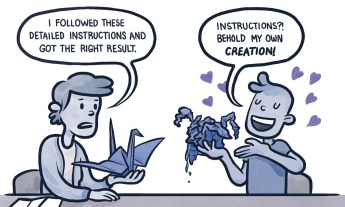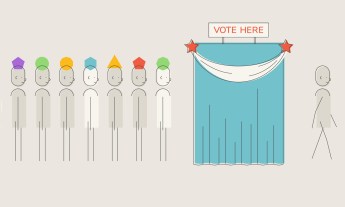
“When we think about how people work, the naïve intuition we have is that people are like rats in a maze,” says behavioral economist Dan Ariely (TED Talk: What makes us feel good about our work?) “We really have this incredibly simplistic view of why people work and what the labor market looks like.”
Instead, when you look carefully at the way people work, he says, you find out there’s a lot more at play — and at stake — than money. Ariely provides evidence that we are also driven by the meaningfulness of our work, by others’ acknowledgement — and by the amount of effort we’ve put in: the harder the task is, the prouder we are.
“When we think about labor, we usually think about motivation and payment as the same thing, but the reality is that we should probably add all kinds of things to it: meaning, creation, challenges, ownership, identity, pride, etc.,” Ariely says.
Below, take a look at some of Ariely’s other studies, as well as a few from other researchers, with interesting implications for what makes us feel good about our work.
- Seeing the fruits of our labor may make us more productive
.
The Study: In Man’s search for meaning: The case of Legos, Ariely asked participants to build characters from Lego’s Bionicles series. In both conditions, participants were paid decreasing amounts for each subsequent Bionicle: $3 for the first one, $2.70 for the next one, and so on. But while one group’s creations were stored under the table, to be disassembled at the end of the experiment, the other group’s Bionicles were disassembled as soon as they’d been built. “This was an endless cycle of them building and we destroying in front of their eyes,” Ariely says.
.
The Results: The first group made 11 Bionicles, on average, while the second group made only seven before they quit.
.
The Upshot: Even though there wasn’t huge meaning at stake, and even though the first group knew their work would be destroyed at the end of the experiment, seeing the results of their labor for even a short time was enough to dramatically improve performance.
. - The less appreciated we feel our work is, the more money we want to do it
.
The Study: Ariely gave study participants — students at MIT — a piece of paper filled with random letters, and asked them to find pairs of identical letters. Each round, they were offered less money than the previous round. People in the first group wrote their names on their sheets and handed them to the experimenter, who looked it over and said “Uh huh” before putting it in a pile. People in the second group didn’t write down their names, and the experimenter put their sheets in a pile without looking at them. People in the third group had their work shredded immediately upon completion.
.
The Results: People whose work was shredded needed twice as much money as those whose work was acknowledged in order to keep doing the task. People in the second group, whose work was saved but ignored, needed almost as much money as those whose work was shredded.
.
The Upshot: “Ignoring the performance of people is almost as bad as shredding their effort before their eyes,” Ariely says. “The good news is that adding motivation doesn’t seem to be so difficult. The bad news is that eliminating motivation seems to be incredibly easy, and if we don’t think about it carefully, we might overdo it.”
. - The harder a project is, the prouder we feel of it
.
The Study: In another study, Ariely gave origami novices paper and instructions to build a (pretty ugly) form. Those who did the origami project, as well as bystanders, were asked at the end how much they’d pay for the product. In a second trial, Ariely hid the instructions from some participants, resulting in a harder process — and an uglier product.
.
The Results: In the first experiment, the builders paid five times as much as those who just evaluated the product. In the second experiment, the lack of instructions exaggerated this difference: builders valued the ugly-but-difficult products even more highly than the easier, prettier ones, while observers valued them even less.
.
The Upshot: Our valuation of our own work is directly tied to the effort we’ve expended. (Plus, we erroneously think that other people will ascribe the same value to our own work as we do.)
. - Knowing that our work helps others may increase our unconscious motivation
.
The Study: As described in a recent New York Times Magazine profile, psychologist Adam Grant led a study at a University of Michigan fundraising call center in which students who had benefited from the center’s scholarship fundraising efforts spoke to the callers for 10 minutes.
.
The Results: A month later, the callers were spending 142 percent more time on the phone than before, and revenues had increased by 171 percent, according to the Times. But the callers denied the scholarship students’ visit had impacted them.
.
The Upshot: “It was almost as if the good feelings had bypassed the callers’ conscious cognitive processes and gone straight to a more subconscious source of motivation,” the Times reports. “They were more driven to succeed, even if they could not pinpoint the trigger for that drive.”
. - The promise of helping others makes us more likely to follow rules
.
The Study: Grant ran another study (also described in the Times profile) in which he put up signs at a hospital’s hand-washing stations, reading either “Hand hygiene prevents you from catching diseases” or “Hand hygiene prevents patients from catching diseases.”
.
The Results: Doctors and nurses used 45 percent more soap or hand sanitizer in the stations with signs that mentioned patients.
.
The Upshot: Helping others through what’s called “prosocial behavior” motivates us.
. - Positive reinforcement about our abilities may increase performance
.
The Study: Undergraduates at Harvard University gave speeches and did mock interviews with experimenters who were either nodding and smiling or shaking their heads, furrowing their eyebrows, and crossing their arms.
.
The Results: The participants in the first group later answered a series of numerical questions more accurately than those in the second group.
.
The Upshot: Stressful situations can be manageable — it all depends on how we feel. We find ourselves in a “challenge state” when we think we can handle the task (as the first group did); when we’re in a “threat state,” on the other hand, the difficulty of the task is overwhelming, and we become discouraged. We’re more motivated and perform better in a challenge state, when we have confidence in our abilities.
. - Images that trigger positive emotions may actually help us focus
.
The Study: Researchers at Hiroshima University had university students perform a dexterity task before and after looking at pictures of either baby or adult animals.
.
The Results: Performance improved in both cases, but more so (10 percent improvement!) when participants looked at cute pictures of puppies and kittens.
.
The Upshot: The researchers suggest that the “cuteness-triggered positive emotion” helps us narrow our focus, upping our performance on a task that requires close attention. Yes, this study may just validate your baby panda obsession.
This post was originally published on the TED Blog in April 2013.
Featured image via iStock.












